Multi-Objective Optimization of Grid Mix Scenarios for Green Hydrogen Production in Germany: Balancing Environmental Impact and Energy Costs
Abstract
1. Introduction
2. Materials and Methods
2.1. Data
- Electricity Cost:
- 2.
- Grid Mix:
- 3.
- Environmental Data:
2.2. Methods
- Environmental impact of the energy mix: Historical data from Figure 2 serves as an input for environmental analysis that quantifies the environmental impact of each power technology. Emission factors including fuel extraction (or raw material extraction), transportation, operation, and decommissioning were applied to calculate the carbon footprint per unit of electricity produced [15]. This study employs the ReCiPe 2016 methodology [16] for impact analysis, focusing on nine selected midpoint categories [12], as detailed in Table 2. ReCiPe 2016 is a widely used life cycle impact analysis method, as shown in Table 1, it is frequently adopted in environmental studies.
- Cost analysis: A cost analysis was conducted based on the historical electricity price data presented in Figure 1. The price of electricity per kilowatt-hour was first determined for the relevant periods. These values were used to estimate the energy costs of hydrogen production through electrolysis. Considering that producing one kilogram of hydrogen consumes approximately 53 kWh of electricity [12], the energy cost per kilogram of hydrogen is obtained by multiplying the historical unit electricity price in Figure 1 by this consumption value. This approach provides a direct and transparent estimate of the electricity-based cost component of hydrogen production. The method highlights the impact of temporal fluctuations in electricity prices on the economics of hydrogen production, enabling historical comparisons and identification of cost-effective periods or regions based on electricity price trends.
- Optimization and scenario analysis: The core objective of this study was to identify electricity grid mix configurations for Germany that minimize both the environmental impact and cost of hydrogen production via AWE over a projected 20-year operational horizon (2025–2045). This is achieved through a multi-objective optimization framework that integrates historical data, policy constraints, surrogate modeling, constrained sampling, and Pareto frontier analysis. The analysis spans 2025 to 2045, in alignment with the national energy transition goals. The scope is limited to grid electricity-based hydrogen production, with environmental burdens quantified on a per-kilogram of hydrogen (kg H2) basis using the ReCiPe 2016 Midpoint LCA Method and the Ecoinvent v3.8 database. The methodological process integrates historical data, surrogate modeling, constrained sampling, predictive analytics, and Pareto optimization. A multi-objective optimization approach aimed at minimizing both lifecycle environmental impacts and economic costs was used. The approach centers on the identification of Pareto-optimal solutions, that is, grid mix configurations for electricity supply in which no objective (cost or environmental impact) can be improved without worsening the other. The detailed breakdown of this methodology is presented below.
- Coal Phase-Out:
- ○
- Hard coal and lignite were capped to zero from 2038 onwards [20].
- Renewable Energy Share:
- Technology-Specific Targets
- ○
- By 2045, wind and solar energy are expected to contribute 60% and 30%, respectively, based on the Fraunhofer ISE projections [22].
- Total Cost (€/kg H2),
- Global Warming Potential (GWP) (kg CO2-eq/kg H2).
- surrogate model prediction of cost (€/kg H2);
- surrogate model prediction of GWP (kg CO2-eq/kg H2).
- convex combination constraint on the energy mix)
- Policy constraints, e.g., to represent phase-out strategies.
- Low-cost–high-impact (economically attractive, environmentally suboptimal).
- High-cost–low-impact (environmentally optimal, economically burdensome).
- Balanced scenarios (favorable compromise between objectives).
| Author | Year | Method |
|---|---|---|
| [15] Ajeeb et al. | 2024 | LCA of renewable energy-sourced alkaline electrolyser technologies using ecoinvent version 3. |
| [26] Koj et al. | 2024 | Life-cycle environmental impacts and costs of alkaline, PEM, and solid oxide water electrolysis technologies under future German electricity mixes using ecoinvent 3.7.1 data |
| [27] Lotrič et al. | 2021 | Use of Ecoinvent 3.5 database for Life-cycle assessment of hydrogen technologies. |
| [28] Hoppe and Minke | 2025 | LCA of a 5 MW alkaline water electrolysis plant with reuse and recycling scenarios using ecoinvent 3.10 and ReCiPe 2016 |
| [16] Huijbergts et al. | 2017 | ReCiPe2016: a harmonized life cycle impact assessment method at midpoint and endpoint level |
| [29] Huang et al. | 2025 | Sustainability assessment of hydrogen production via water electrolysis in China with different photovoltaics-battery-grid systems using ReCiPe 2016 |
| [30] Dincer and Agelin-Chaap | 2025 | LCA of electrolysis based green hydrogen production pathways using ReCiPe 2016 |
| [31] Mehmeti et al. | 2018 | LCA to assess the performance of hydrogen production with fossil and renewable energy sources via high-temperature Solid Electrolysis Cells using ReCiPe2016 |
| [32] Kiss & Szalay | 2023 | Multi-objective optimization approach to predict the sensitivity of buildings. |
| Impact Category | Abbreviation | Unit | Level |
|---|---|---|---|
| Acidification | AP | Mole of H+-eqv. | Midpoint |
| Climate change | GWP | kg CO2-eqv. | Midpoint |
| Eutrophication freshwater | EP fw | kg P-eqv. | Midpoint |
| Eutrophication marine | EP sw | kg N-eqv. | Midpoint |
| Eutrophication terrestrial | EP ter | Mole of N-eqv. | Midpoint |
| Ozone depletion | ODP | kg CFC-11-eqv. | Midpoint |
| Respiratory inorganics | PM | kg PM2.5-eqv. | Midpoint |
| Photochemical ozone formation | POCP | kg NMVOC-eqv. | Midpoint |
| Abiotic depletion potential | ADP | kg Sb-eqv. | Midpoint |
3. Results
3.1. Environmental Results
3.2. Cost Results
3.3. Overview of the Pareto Optimization Results
- Renewable energy sources (Biomass, Hydropower, Solar, Wind, and others) dominate the energy mix, with wind (mean = 30%) and solar (mean = 15.53%) being particularly prominent.
- High variability is observed in the shares of hydropower and mineral oil energy (CoV > 0.7), indicating flexibility in how these sources contribute to different cost–impact trade-offs.
- Nuclear energy plays a crucial balancing role (mean: 10.7%), providing dispatchable baseloads to complement variable renewables.
- The high standard deviation-to-mean ratios for fossil fuels underscore the necessity of transition to account for volatility and uncertainty, especially under evolving technology costs and policy pressures.
4. Discussion
4.1. Sensitivity Analysis Using OFAT Methodology
- and are the output values (GWP or cost) after increasing and decreasing input by 10%, respectively;
- is the magnitude of the perturbation (10% of );
- is the baseline value of the input;
- is the baseline output value (GWP or cost).
4.2. Methodological Advancements and Policy-Constrained
4.3. Sensitivity to Renewable Share and Energy Sources
4.4. Interpretation of Trade-Offs and Model Limitations
- Low-GWP scenarios (e.g., 23.61 kg CO2-eq/kg H2 in 2033) demand high shares of intermittent renewables such as solar and hydropower but incur elevated costs (up to 12 €/kg H2), likely due to assumed storage, curtailment, or import penalties.
- Low-cost scenarios (e.g., 9.04 €/kg H2 in 2025) contain high reliance on contributions from subsidized or legacy sources (e.g., hard coal, nuclear) and are interpreted as artifacts of extrapolation in the surrogate model, likely infeasible under stringent EU 2030/2045 climate targets. These results highlight the limitations of surrogate model generalization, particularly when the training data are sparse or extrapolated.
4.5. Policy and Technological Implications
- Feasibility of Renewable Targets: Achieving ≥80% renewable electricity in the hydrogen supply is technically feasible post-2030, contingent on a diversified generation portfolio and adequate dispatchable reserves.
- Role of Clean Baseload: High shares of hydropower, biomass, and potentially nuclear (or modular/fusion-based substitutes) are critical for maintaining low GWP while containing costs.
- Technology Neutrality: Some scenarios include moderate nuclear and natural gas with carbon capture (CCS, modeled via proxy), suggesting that technology-neutral frameworks may offer greater flexibility in achieving dual objectives.
- Cost-Impact Trade-Offs: GWP reductions below 25 kg CO2-eq/kg H2 consistently correlated with costs above 9 €/kg H2. Carbon pricing, subsidies, and green premiums are essential to bridge this gap.
- Sequencing Matters: The temporal alignment of the coal exit, renewable ramp-up, and infrastructure deployment critically determines the environmental and economic profiles of hydrogen. “Balanced” scenarios—such as that in 2034—should be prioritized for investment modeling, regulatory focus, and incentive schemes.
- Scenarios identified as “balanced” should be prioritized for investment modeling and policy incentivization because of their dual performance.
- Trade-off solutions, such as the Balanced Scenario (2034), offer the most viable pathways for balancing grid feasibility, cost efficiency, and environmental performance.
5. Conclusions
- Policy-Constrained Optimization Framework: A dynamic, policy-compliant, multi-objective optimization framework was developed that integrates national energy targets into hydrogen planning, avoiding the unrealistic assumptions common in unconstrained models.
- Dynamic Grid Mix Surrogates: The study replaces static assumptions of electricity sourcing with a time-series-based surrogate model that reflects the evolution of Germany’s grid mix over a 20-year period (2025–2045). This enables realistic temporal mapping of the energy input structure in hydrogen production scenarios.
- Quantified Transition Benchmarks: A feasible cost-impact trade-off is identified, providing clear actionable targets for hydrogen producers and policymakers.
Author Contributions
Funding
Data Availability Statement
Conflicts of Interest
Nomenclature
| ADP | Abiotic Depletion Potential |
| AP | Acidification |
| AWE | Alkaline Water Electrolysis |
| CCS | Carbon Capture and Storage |
| CoV | Coefficient of Variation |
| cLHS | Constrained Latin Hypercube Sampling |
| EP fw | Eutrophication freshwater |
| EP sw | Eutrophication marine |
| EP ter | Eutrophication terrestrial |
| GPR | Gaussian Process Regression |
| GWP | Global Warming Potential |
| LCA | Life Cycle Assessment |
| LCOE | Levelized Cost of Electricity |
| ODP | Ozone depletion |
| PM | Particulate Matter |
| POCP | Photochemical ozone formation |
| PV | Photovoltaics |
| RES | Renewable Energy Surcharge |
| StromNEV | Regulation on Fees for Access to Electricity Supply Grids |
References
- Franco, A.; Giovannini, C. Recent and Future Advances in Water Electrolysis for Green Hydrogen Generation: Critical Analysis and Perspectives. Sustainability 2023, 15, 16917. [Google Scholar] [CrossRef]
- Dash, S.; K, A.S.; S, J.; D, V.H.W.; D, E.; Surapraraju, S.K.; Natarajan, S.K. Advances in green hydrogen production through alkaline water electrolysis: A comprehensive review. Int. J. Hydrogen Energy 2024, 83, 614–629. [Google Scholar] [CrossRef]
- Lee, B.; Cho, H.-S.; Kim, H.; Lim, D.; Cho, W.; Kim, C.-H.; Lim, H. Integrative techno-economic and environmental assessment for green H2 production by alkaline water electrolysis based on experimental data. J. Environ. Chem. Eng. 2021, 9, 106349. [Google Scholar] [CrossRef]
- Gerloff, N. Comparative Life-Cycle-Assessment analysis of three major water electrolysis technologies while applying various energy scenarios for a greener hydrogen production. J. Energy Storage 2021, 43, 102759. [Google Scholar] [CrossRef]
- Petelet, M.; Iooss, B.; Asserin, O.; Loredo, A. Latin hypercube sampling with inequality constraints. AStA Adv. Stat. Anal. 2010, 94, 325–339. [Google Scholar] [CrossRef]
- Giannelos, S.; Zhang, X.; Zhang, T.; Strbac, G. Multi-Objective Optimization for Pareto Frontier Sensitivity Analysis in Power Systems. Sustainability 2024, 16, 5854. [Google Scholar] [CrossRef]
- Baños, R.; Manzano-Agugliaro, F.; Montoya, F.G.; Gil, C.; Alcayde, A.; Gómez, J. Optimization methods applied to renewable and sustainable energy: A review. Renew. Sustain. Energy Rev. 2011, 15, 1753–1766. [Google Scholar] [CrossRef]
- World Energy Outlook 2024—Analysis—IEA. Available online: https://www.iea.org/reports/world-energy-outlook-2024 (accessed on 17 June 2025).
- Global Energy Perspective 2024 | McKinsey. Available online: https://www.mckinsey.com/industries/energy-and-materials/our-insights/global-energy-perspective#/ (accessed on 17 June 2025).
- Zeng, Y.; Jiang, S.; Konstantinou, G.; Pou, J.; Zou, G.; Zhang, X. Multi-Objective Controller Design for Grid-Following Converters With Easy Transfer Reinforcement Learning. IEEE Trans. Power Electron. 2025, 40, 6566–6577. [Google Scholar] [CrossRef]
- Eurostat. Electricity Prices for Non-Household Consumers—Bi-Annual Data (from 2007 Onwards). 2022. Available online: https://ec.europa.eu/eurostat/databrowser/product/page/NRG_PC_205 (accessed on 22 May 2025).
- Koj, J.; Wulf, C.; Schreiber, A.; Zapp, P. Site-Dependent Environmental Impacts of Industrial Hydrogen Production by Alkaline Water Electrolysis. Energies 2017, 10, 860. [Google Scholar] [CrossRef]
- Bruttostromerzeugung Nach Energieträgern in Deutschland ab 1990. Available online: https://www.destatis.de/DE/Themen/Branchen-Unternehmen/Energie/Erzeugung/bar-chart-race.html (accessed on 22 May 2025).
- Ecoinvent Version 3.8. Available online: https://support.ecoinvent.org/ecoinvent-version-3.8 (accessed on 18 June 2025).
- Ajeeb, W.; Baptista, P.; Neto, R.C. Life cycle analysis of hydrogen production by different alkaline electrolyser technologies sourced with renewable energy. Energy Convers. Manag. 2024, 316, 118840. [Google Scholar] [CrossRef]
- Huijbregts, M.A.J.; Steinmann, Z.J.N.; Elshout, P.M.F.; Stam, G.; Verones, F.; Vieira, M.; Zijp, M.; Hollander, A.; van Zelm, R. ReCiPe2016: A harmonised life cycle impact assessment method at midpoint and endpoint level. Int. J. Life Cycle Assess. 2017, 22, 138–147. [Google Scholar] [CrossRef]
- Neupane, B.; Belkadi, F.; Formentini, M.; Rozière, E.; Hilloulin, B.; Abdolmaleki, S.F.; Mensah, M. Machine learning algorithms for supporting life cycle assessment studies: An analytical review. Sustain. Prod. Consum. 2025, 56, 37–53. [Google Scholar] [CrossRef]
- Prina, M.G.; Dallapiccola, M.; Moser, D.; Sparber, W. Machine learning as a surrogate model for EnergyPLAN: Speeding up energy system optimization at the country level. Energy 2024, 307, 132735. [Google Scholar] [CrossRef]
- Naser, A.Z.; Defersha, F.; Xu, X.; Yang, S. Automating life cycle assessment for additive manufacturing with machine learning: Framework design, dataset buildup, and a case study. J. Manuf. Syst. 2023, 71, 504–526. [Google Scholar] [CrossRef]
- Bundesfinanzministerium—Kohleausstieg Zur Erfüllung der Klimaschutzziele Bei Gleichzeitiger Sicherstellung der Energieversorgung. Available online: https://www.bundesfinanzministerium.de/Content/DE/Standardartikel/Themen/Schlaglichter/Nachhaltigkeitsstrategie/kohleausstieg.html (accessed on 30 June 2025).
- BMWE—Erneuerbare Energien. Available online: https://www.bundeswirtschaftsministerium.de/Redaktion/DE/Dossier/erneuerbare-energien.html (accessed on 30 June 2025).
- Studie: Wege zu Einem Klimaneutralen Energiesystem—Bundesländer Im Transformationsprozess—Fraunhofer ISE. Available online: https://www.ise.fraunhofer.de/de/veroeffentlichungen/studien/wege-zu-einem-klimaneutralen-energiesystem.html (accessed on 30 June 2025).
- Schmeling, L.; Buchholz, A.A.I.; Heineke, H.; Klement, P.; Hanke, B.; von Maydell, K. Planning, Optimisation and Evaluation of Small Power-to-Gas-to-Power Systems: Case Study of a German Dairy. Sustainability 2022, 14, 6050. [Google Scholar] [CrossRef]
- Hartigan, J.A.; Wong, M.A. Algorithm AS 136: A K-Means Clustering Algorithm. J. R. Stat. Soc. Ser. C Appl. Stat. 1979, 28, 100–108. [Google Scholar] [CrossRef]
- Surucu, O.; Gadsden, S.A.; Yawney, J. Condition Monitoring using Machine Learning: A Review of Theory, Applications, and Recent Advances. Expert Syst. Appl. 2023, 221, 119738. [Google Scholar] [CrossRef]
- Koj, J.C.; Zapp, P.; Wieland, C.; Görner, K.; Kuckshinrichs, W. Life cycle environmental impacts and costs of water electrolysis technologies for green hydrogen production in the future. Energy Sustain. Soc. 2024, 14, 64. [Google Scholar] [CrossRef]
- Lotrič, A.; Sekavčnik, M.; Kuštrin, I.; Mori, M. Life-cycle assessment of hydrogen technologies with the focus on EU critical raw materials and end-of-life strategies. Int. J. Hydrogen Energy 2021, 46, 10143–10160. [Google Scholar] [CrossRef]
- Hoppe, A.C.; Minke, C. Reducing Environmental Impacts of Water Electrolysis Systems by Reuse and Recycling: Life Cycle Assessment of a 5 MW Alkaline Water Electrolysis Plant. Energies 2025, 18, 796. [Google Scholar] [CrossRef]
- Huang, X.; Jeswani, H.K.; Azapagic, A. Sustainability assessment of hydrogen production via water electrolysis considering different configurations of solar photovoltaics-battery-grid systems in China. Sustain. Prod. Consum. 2025, 56, 221–244. [Google Scholar] [CrossRef]
- Dincer, M.; Agelin-Chaab, M. Sustainability analysis of electrolysis based green hydrogen production pathways: A life cycle perspective. Int. J. Hydrogen Energy 2025, 138, 617–625. [Google Scholar] [CrossRef]
- Mehmeti, A.; Angelis-Dimakis, A.; Muñoz, C.B.; Graziadio, M.; McPhail, S.J. Eco-thermodynamics of hydrogen production by high-temperature electrolysis using solid oxide cells. J. Clean. Prod. 2018, 199, 723–736. [Google Scholar] [CrossRef]
- Kiss, B.; Szalay, Z. Sensitivity of buildings’ carbon footprint to electricity decarbonization: A life cycle–based multi-objective optimization approach. Int. J. Life Cycle Assess. 2023, 28, 933–952. [Google Scholar] [CrossRef]
- Bundesfinanzministerium—E—EEG-Umlage. Available online: https://www.bundesfinanzministerium.de/Web/DE/Service/FAQ_Glossar/Glossar/Functions/glossar.html?lv2=176620&lv3=176670 (accessed on 23 June 2025).
- Strompreis Entwicklung in Deutschland Für Haushalte Und Industrie | BDEW. Available online: https://www.bdew.de/service/daten-und-grafiken/bdew-strompreisanalyse/ (accessed on 20 June 2025).
- Hamby, D.M. A review of techniques for parameter sensitivity analysis of environmental models. Environ. Monit. Assess. 1994, 32, 135–154. [Google Scholar] [CrossRef] [PubMed]
- Groen, E.A.; Bokkers, E.A.M.; Heijungs, R.; de Boer, I.J.M. Methods for global sensitivity analysis in life cycle assessment. Int. J. Life Cycle Assess. 2017, 22, 1125–1137. [Google Scholar] [CrossRef]
- Schindler, D.; Sander, L.; Jung, C. Importance of renewable resource variability for electricity mix transformation: A case study from Germany based on electricity market data. J. Clean. Prod. 2022, 379, 134728. [Google Scholar] [CrossRef]
- Maniscalco, M.P.; Longo, S.; Cellura, M.; Miccichè, G.; Ferraro, M. Critical Review of Life Cycle Assessment of Hydrogen Production Pathways. Environments 2024, 11, 108. [Google Scholar] [CrossRef]
- Ajeeb, W.; Neto, R.C.; Baptista, P. Comparative Life Cycle Analysis of Electrolysis Hydrogen Production from Diverse Green Energy Sources. In Technological Advancements and Future Directions in Green Energy; Peng, Z., Ed.; Green Energy and Technology; Springer Nature: Cham, Switzerland, 2025; pp. 49–61. ISBN 978-3-031-83202-4. [Google Scholar]
- BASE—Small Modular Reactors (SMR). Available online: https://www.base.bund.de/en/nuclear-safety/nuclear-technology/small-modular-reactors/small-modular-reactors_content.html (accessed on 23 June 2025).
- BASE—Nuclear Phase-Out. Available online: https://www.base.bund.de/en/nuclear-safety/nuclear-phase-out/nuclear-phase-out_content.html (accessed on 23 June 2025).
- New Performance Records Wendelstein 7-X. Available online: https://www.ipp.mpg.de/5532945/w7x (accessed on 23 June 2025).
- ITER—The Way to New Energy. Available online: https://www.iter.org/ (accessed on 23 June 2025).
- Prina, M.G.; Barchi, G.; Osti, S.; Moser, D. Optimal future energy mix assessment considering the risk of supply for seven European countries in 2030 and 2050. e-Prime—Adv. Electr. Eng. Electron. Energy 2023, 5, 100179. [Google Scholar] [CrossRef]
- Kirchem, D.; Schill, W.-P. Power sector effects of green hydrogen production in Germany. Energy Policy 2023, 182, 113738. [Google Scholar] [CrossRef]




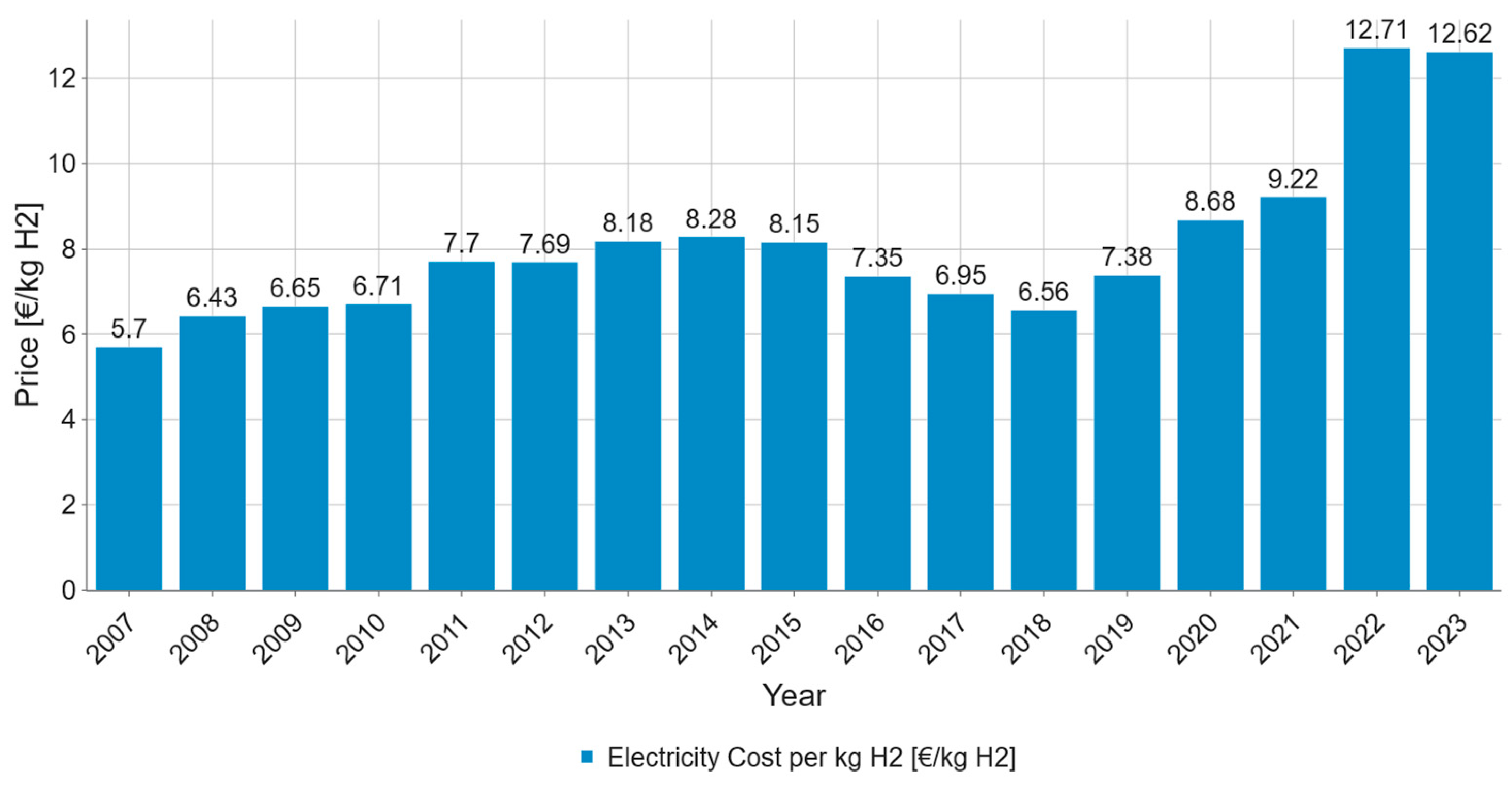
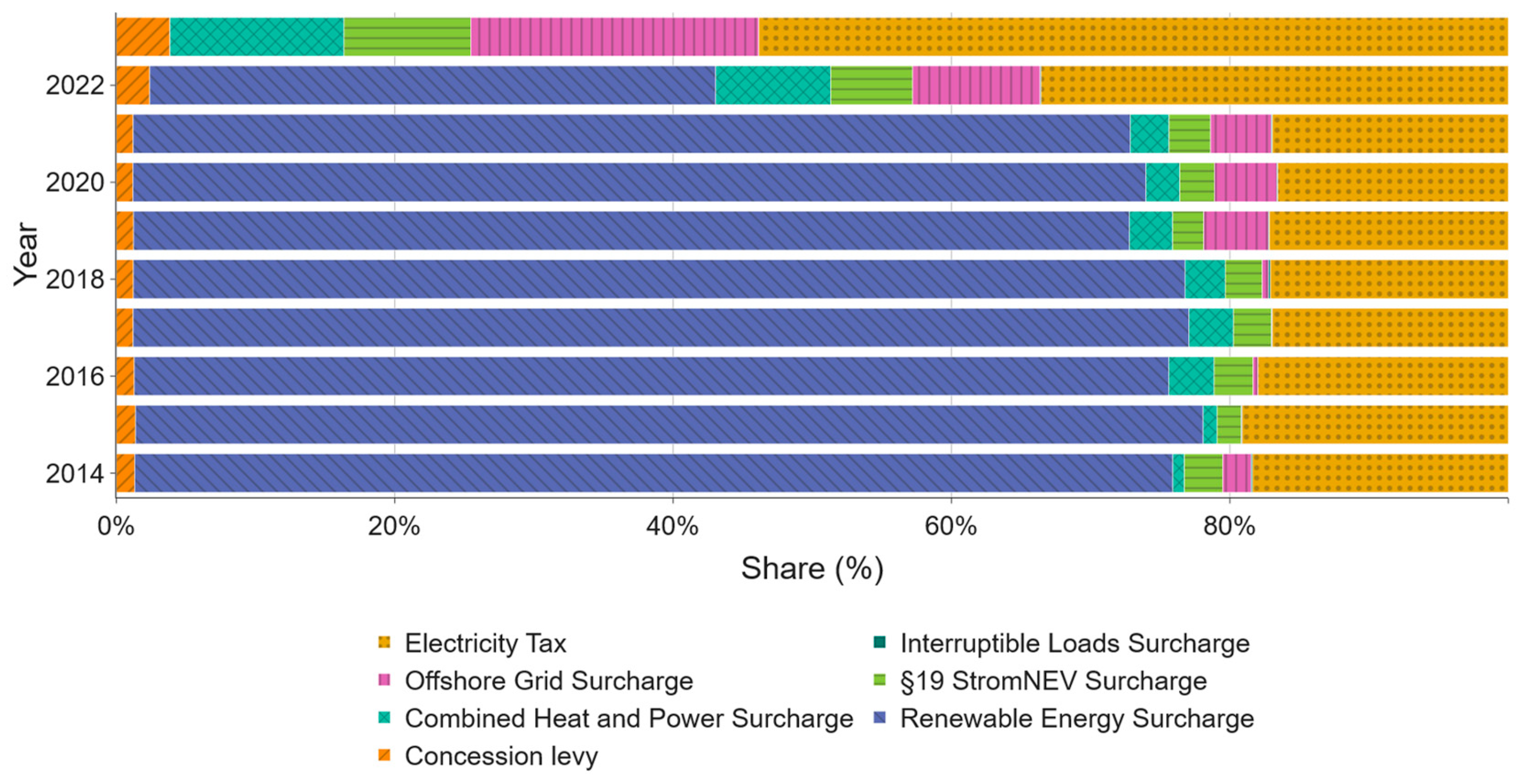
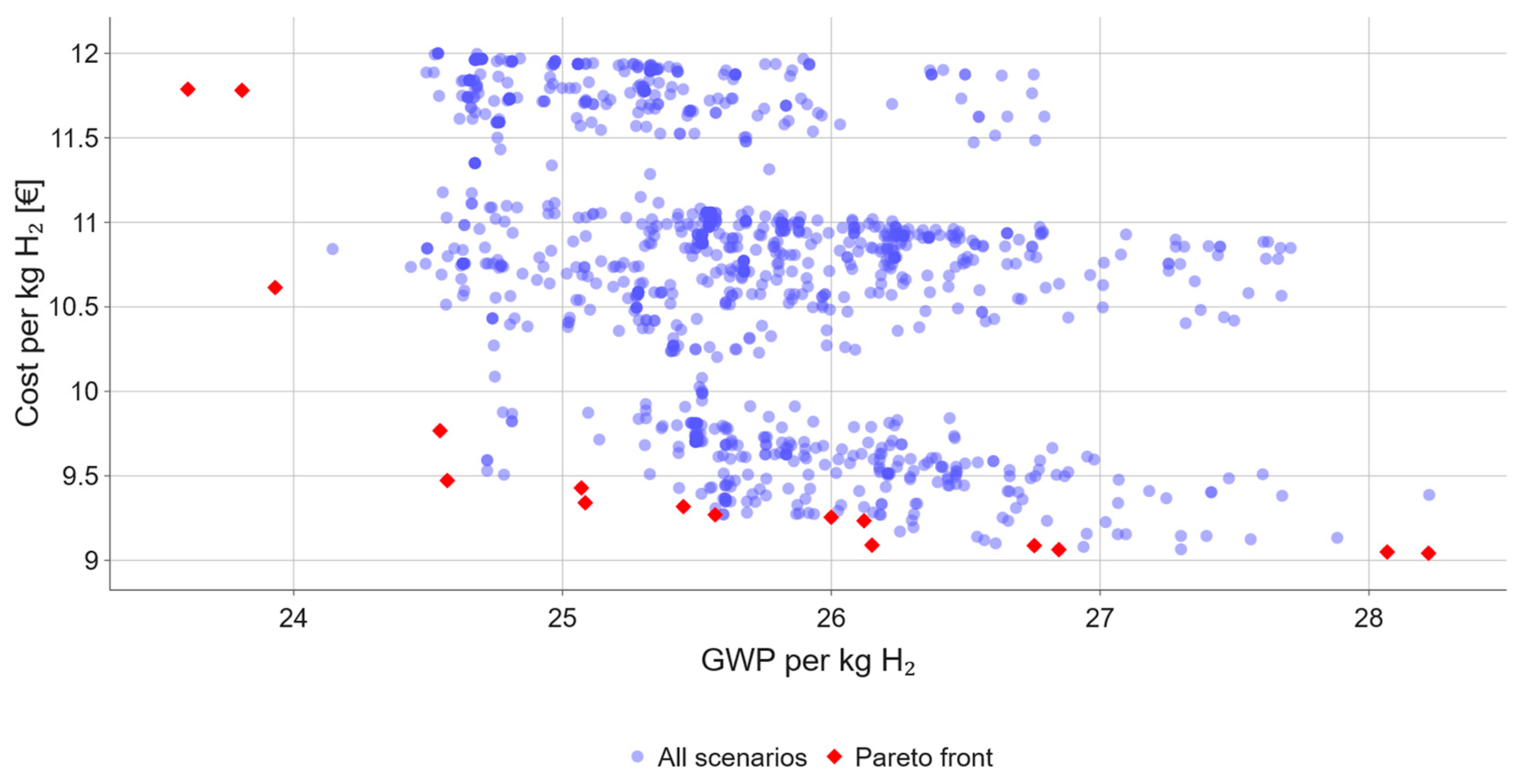
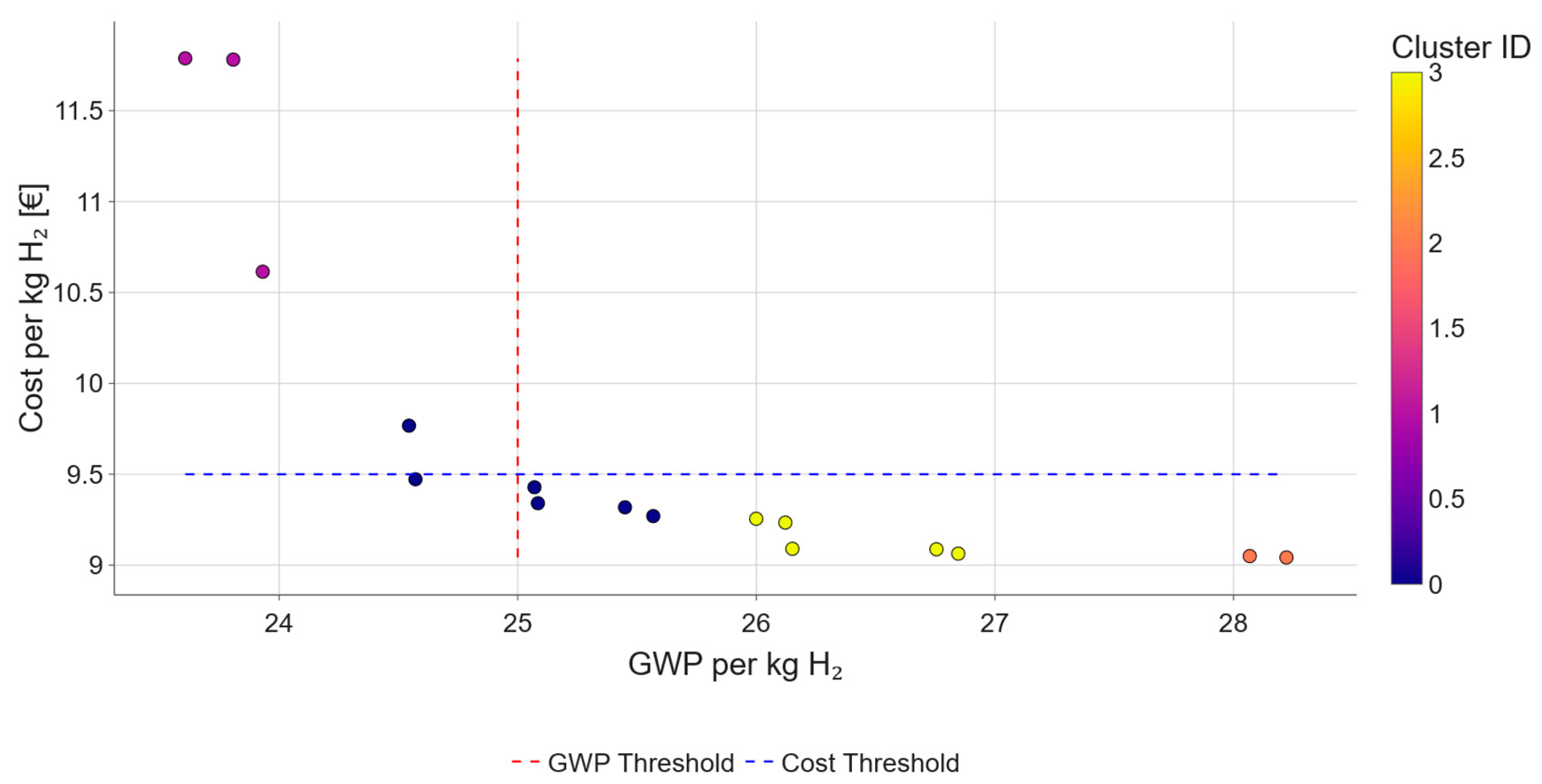
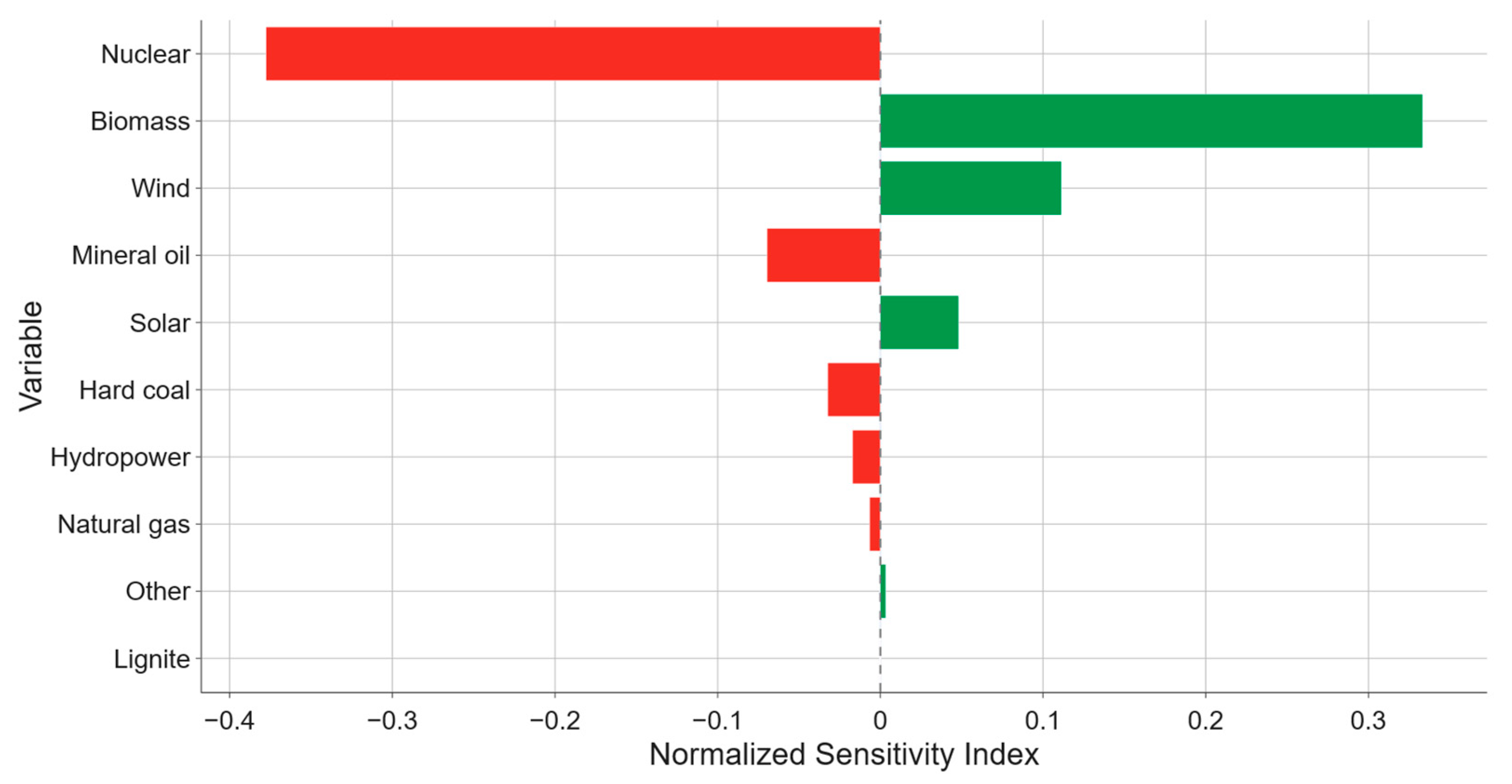
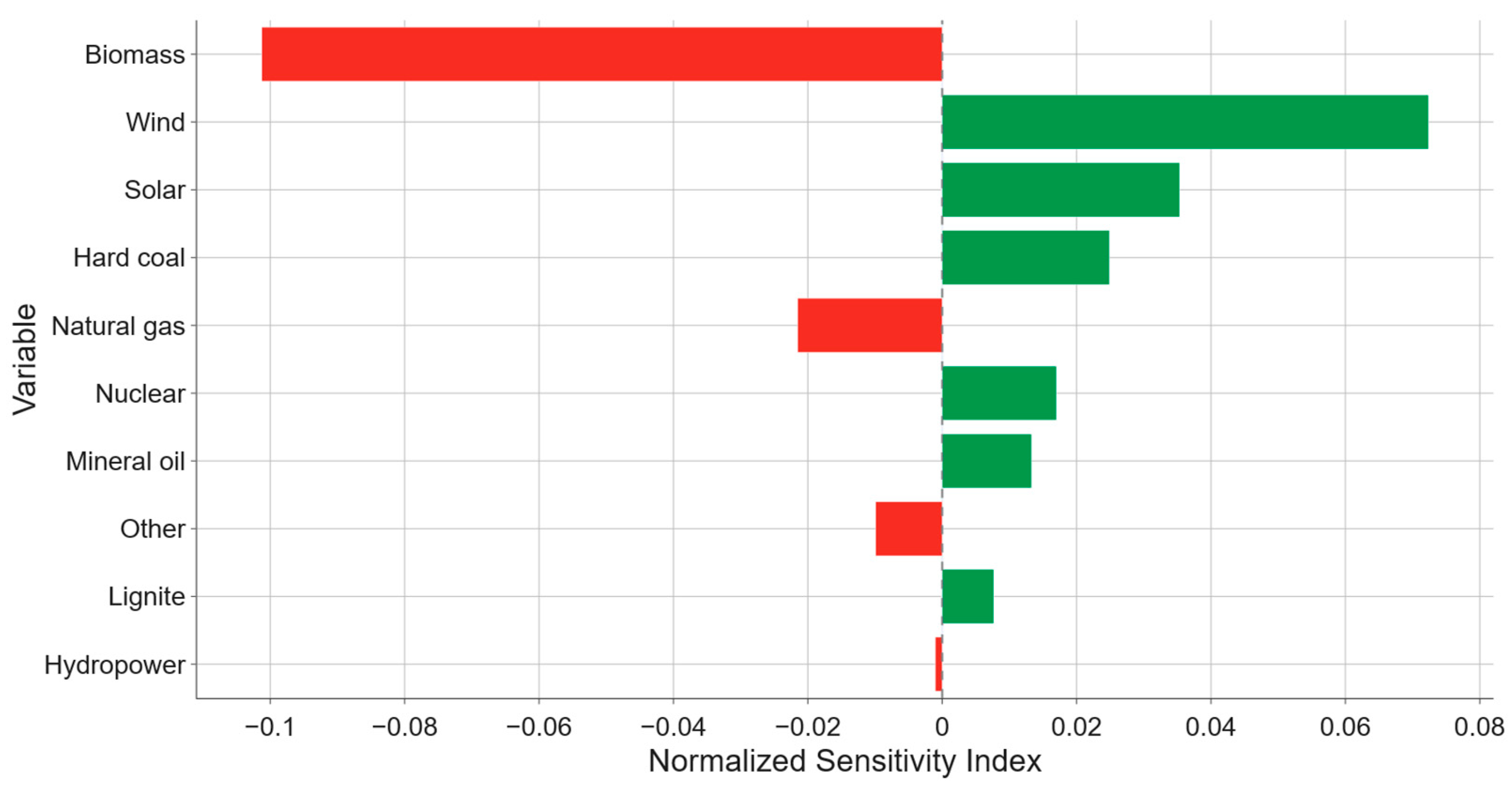
| Source | Mean (%) | Std (%) | Min (%) | Max (%) | CoV (Std/Mean) | Interpretation |
|---|---|---|---|---|---|---|
| Biomass | 5.13 | 3.11 | 0.70 | 10.43 | 0.61 | Varied use; contributes more in greener scenarios. |
| Hard Coal | 7.24 | 3.77 | 2.10 | 13.64 | 0.52 | Phase-out trend; minimized in GWP-focused scenarios |
| Hydropower | 1.58 | 1.53 | 0.00 | 5.08 | 0.97 | Limited capacity expansion; variable in low GWP setups. |
| Lignite | 6.69 | 3.47 | 0.58 | 13.32 | 0.52 | Similar to hard coal; reduced in greener scenarios. |
| Mineral Oil | 6.27 | 4.38 | 0.09 | 13.01 | 0.70 | High variability; mostly reduced in low GWP scenarios. |
| Natural Gas | 10.99 | 6.30 | 0.97 | 19.80 | 0.57 | Highly variable; used flexibly depending on trade-off strategy. |
| Nuclear | 10.70 | 4.41 | 0.97 | 17.34 | 0.41 | Controlled variability; serves as a flexible baseload or transition source. |
| Other | 5.86 | 4.01 | 0.33 | 15.70 | 0.68 | Catch-all category; includes flexibility levers like imports or renewables. |
| Solar | 15.53 | 1.27 | 15.00 | 19.46 | 0.08 | Slight variability, likely operating at technical or spatial capacity limits. |
| Wind | 30.00 | 0.00 | 30.00 | 30.00 | 0.00 | Fixed share across all scenarios; strong policy constraint or saturation effect. |
| Cluster | Count | General Strategy | Dominant Traits |
|---|---|---|---|
| 0 (Dark blue) | 6 | Balanced Transition | High diversification, moderate cost and GWP |
| 1 (Purple) | 3 | GWP-Minimization | High renewables, high gas, low nuclear/fossils |
| 2 (Orange) | 2 | Cost-Minimization | High fossil share, minimized renewables except solar/wind |
| 3 (Yellow) | 5 | Hybrid Strategies | Intermediate between Cluster 0 and 1 |
Disclaimer/Publisher’s Note: The statements, opinions and data contained in all publications are solely those of the individual author(s) and contributor(s) and not of MDPI and/or the editor(s). MDPI and/or the editor(s) disclaim responsibility for any injury to people or property resulting from any ideas, methods, instructions or products referred to in the content. |
© 2025 by the authors. Licensee MDPI, Basel, Switzerland. This article is an open access article distributed under the terms and conditions of the Creative Commons Attribution (CC BY) license (https://creativecommons.org/licenses/by/4.0/).
Share and Cite
Mysore Guruprasad, S.; Chen, Y.; Müller, A.-K.; Sultan, G.; Flore, A. Multi-Objective Optimization of Grid Mix Scenarios for Green Hydrogen Production in Germany: Balancing Environmental Impact and Energy Costs. Fuels 2025, 6, 85. https://doi.org/10.3390/fuels6040085
Mysore Guruprasad S, Chen Y, Müller A-K, Sultan G, Flore A. Multi-Objective Optimization of Grid Mix Scenarios for Green Hydrogen Production in Germany: Balancing Environmental Impact and Energy Costs. Fuels. 2025; 6(4):85. https://doi.org/10.3390/fuels6040085
Chicago/Turabian StyleMysore Guruprasad, Shreyas, Yajing Chen, Ann-Katrin Müller, Gabriel Sultan, and Agnetha Flore. 2025. "Multi-Objective Optimization of Grid Mix Scenarios for Green Hydrogen Production in Germany: Balancing Environmental Impact and Energy Costs" Fuels 6, no. 4: 85. https://doi.org/10.3390/fuels6040085
APA StyleMysore Guruprasad, S., Chen, Y., Müller, A.-K., Sultan, G., & Flore, A. (2025). Multi-Objective Optimization of Grid Mix Scenarios for Green Hydrogen Production in Germany: Balancing Environmental Impact and Energy Costs. Fuels, 6(4), 85. https://doi.org/10.3390/fuels6040085








